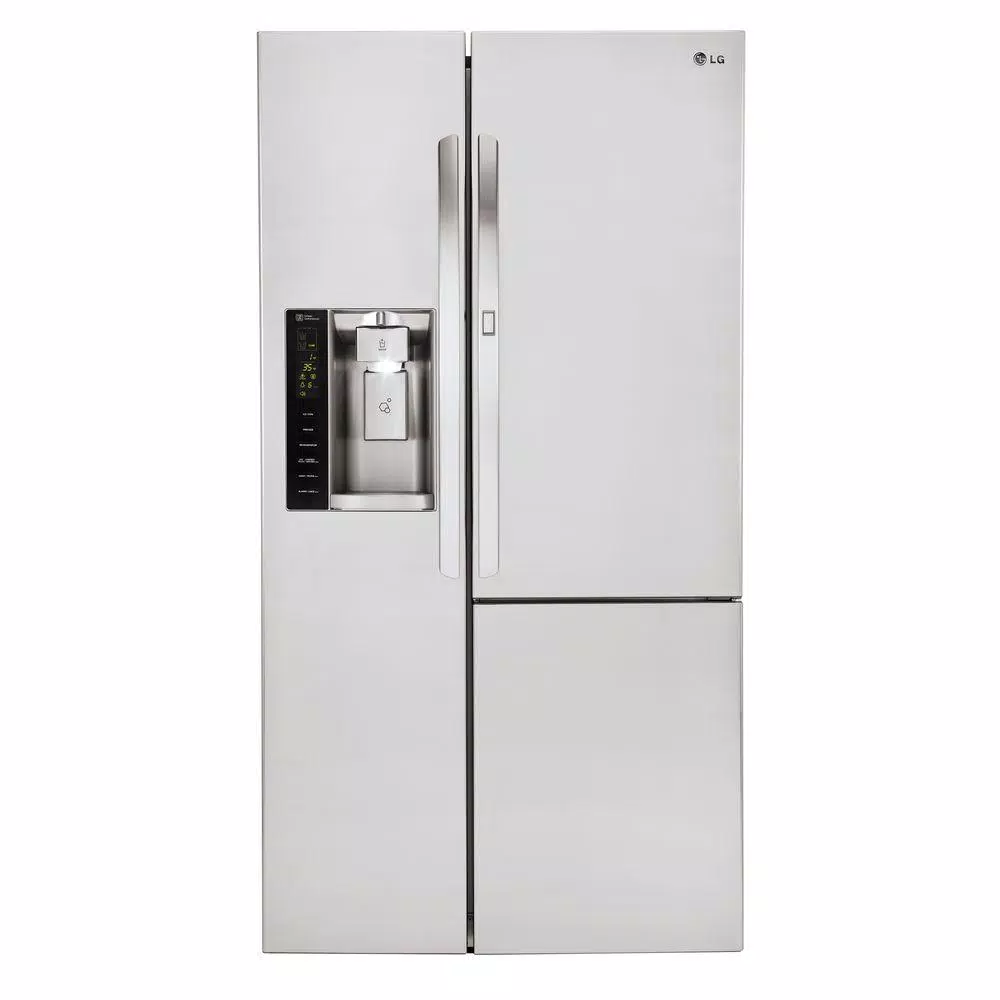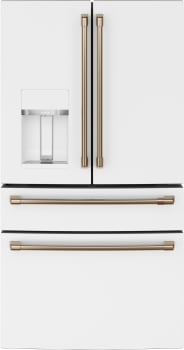LG Electronics 26.2 cu. ft. French Door Smart Refrigerator with Wi-Fi Enabled in Black Stainless Steel
Store more food with an Ultra-Large Capacity refrigerator. Fingerprint resistant finish & Slim SpacePlus ice door system. Smart Home & Wi-Fi enabled to operate & troubleshoot on phone app.
Now you can keep your refrigerator organized instead of just wishing you could. With 26 cu. ft. to work with, you get lots of great space and two ice makers to keep plenty of ice on hand for the family reunion. Plus, our Smart Cooling technology is designed to help keep all your food fresher, longer.
-
Stock-up and store everything you need. With a cavernous 26 cu. ft. of space, this LG French Door refrigerator gives you ample space for all of your family’s favorite foods and keeps them conveniently organized and within reach.
- Dual ice makers, dispensed from the door and located in the freezer compartment, produce large amounts of ice so you never run out. This extra ice storage helps ensure that you have extra ice on hand for those hot summer days or when entertaining large parties
- From making extra ice for tonight’s dinner party while you’re at work to adjusting temperatures with simple voice commands, LG refrigerators with SmartThinQ technology will change the way you think and the way you live. Simply download the free LG SmartThinQ app to your Android or iOS device and let the possibilities unfold. Receive notifications on your smartphone when the door is open or your water filter needs to be replaced. Control refrigerator and freezer temperatures remotely. Diagnose issues and get quick, expert advice.
- Ice makers are great, but not if it means you can’t fit all of your food in the fridge. The Slim SpacePlus Ice System provides the most shelf space and allows even more space for door bins.
- Smart Cooling system is designed to maintain superior conditions within the refrigerator. The Linear Compressor reacts quickly to temperature fluctuations and helps keep your food fresher, longer. Meanwhile, strategically-placed vents in every section help to surround your food with cool air no matter where you put it.
- From pitchers to pint glasses, finally an ice and water dispenser that can accommodate just about any container. The water and ice dispenser in this LG 4-Door refrigerator is one of the tallest around, measuring in at an ultra-accommodating 12.6 in.
- 2-Tier Organization Freezer 2-Tier Organization Freezer
- SmartDiagnosis helps the service center diagnose problems over the phone, helping you troubleshoot quickly.
- Two humidity-controlled crisper drawers, a full-width Glide-N-Serve drawer, and a bonus drawer for fruits and vegetables make party preparations easy.
- This ENERGY STAR qualified LG refrigerator exceeds federal energy standards to positively impact your energy bill, your energy consumption, and most importantly, the environment.
- When you buy a refrigerator, you don’t want to worry that it won’t last. Because the Linear Compressor motor uses fewer moving parts and operates more efficiently, LG confidently backs the motor with a 10-year limited warranty.
- Use the voice-activated features of Google Assistant or Amazon Alexa. LG makes it easy to keep your cool in any situation. Let the advantages of smart technology work for you.
Additional information
| Depth (Excluding Handles) | 32.38 |
|---|---|
| Depth (Including Handles) | 34.88 |
| Depth (Less Door) | 28.5 |
| Depth With Door Open 90 Degrees (In) | 47.125 |
| Height to Top of Door Hinge (in.) | 69.75 |
| Height to Top of Refrigerator (in.) | 68.38 |
| Product Depth x Height x Width (in.) | 34.88 x 68.38 x 35.75 |
| Refrigerator Width (In.) | 35.75 |
| Certifications and Listings | UL Listed |
| Manufacturer Warranty | 1 Year Parts & Labor, 5 Years Sealed System, 5 Years Compressor, 10 Years Linear Compressor Parts Only |






by Mikey
It’s been about 8 months ago we love the size in side of it I like the ice tray in the bottom of the freezer
by Texas
Pros about this refrigerator: love that it has two ice makers. Smaller than my last refrigerator, but the configuration allows for plenty of room. It’s very quiet. The cubes from the door are smaller than the ones in the freezer but are a perfect size. Which leads to the only con—the left door which houses the top ice maker is very heavy and has a tendency to slam shut. Also, not sure what the purpose of wifi is, but I’m sure some people might use it.
by Ima
I had been thinking about replacing our side by side refrigerator for a long time as I found it very difficult to find items in it, particularly on lower shelves toward the back. When I finally convinced my husband to look for a new replacement refrigerator, we began our research on different models. After weighing the pros and cons of many models out there, we decided on the LG French Door Model LFXS26973S. We absolutely love all of its features, the amount of room on the shelves, the configuration of shelves on the doors, even down to the size of the ice cubes! And we love the extra ice bin in the bottom pull-out drawer. We are extremely happy all the way around with this wonderful refrigerator! Thank you so much LG!!!
by Tony
We remodeled our kitchen and it fits perfectly and looks perfect.
by Matt
Gorgeous! Lots of room inside. Only thing is the vegetable drawers are smaller than I’d like. Overall a very nice appliance. I would definitely recommend. Elevates my kitchen to another level.
by Rick
I love the look and features of this refrigerator I’m also happy about how spacious it feels.
by James
Excellent fridge with high marks and easy recommendation. French doors and simple design make this fridge easy to use and large capacity. Dual ice option and easy clean external water supply made it even better. The in door ice machine is flat and not too bulky so you don’t lose fridge space like other models. That’s the beauty of ThinQ. The fridge alarms you when the door is open and can link to your phone also. We love this fridge! Covid made for slower delivery time by a month but it was well worth the wait. I highly recommend this fridge! Enjoy!
by Glade
The Frig was purchased a month ago, and we are extremely happy we chose the LG. Its functions are suited for our needs perfectly, its size is exactly what we needed. And the cost was fair.
by Bill
Our thirteen year old LG made some groaning noises and then took its last breath. Went on the HD website around the end of June and chose this unit based on manufacturer and dimensions . Ordered it and bought a small magic chef to get through as delivery was not going to happen until 30 days later. You know that fridge came exactly the day they said it would. I figured two days before we would get a call to say it was delayed, nope. I was impressed. The delivery was excellent. They guys did a great job wrestling out the old and bringing in the new. The LG works well. Very quiet and a competent ice maker. There are a few things I might have preferred with the drawer layout but I will adapt. And yes no fingerprints on the stainless. Recommend this refrigerator.